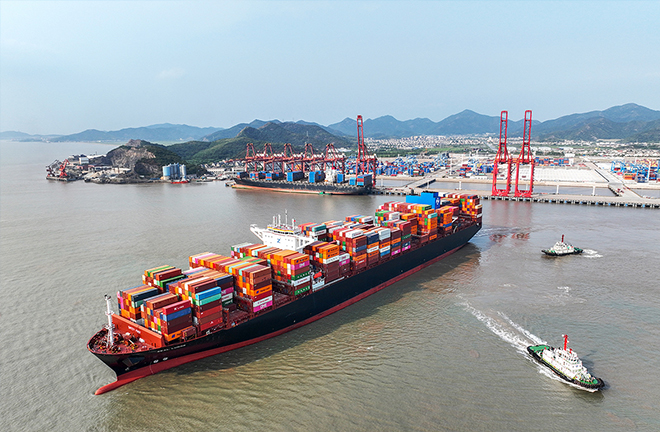Safeguarding industrial and supply chains

The Port of Zhoushan Ningbo stablizes supply and industrial chains. Photo: CFP
At present, confronted by challenges from restructuring of global value chains (GVCs), with guidance from the new development paradigm, an imminent task for China’s high-quality development is to effectively make industrial and supply chains more independent and controllable, and to ensure their security and stability.
Increasing risks
Countries’ focuses have shifted from “efficiency” to “security.” This further accelerates adjustments and restructuring of GVCs, reshaping them, which makes space for a transition towards shorter chains, localization, decentralization, and greening, posing new challenges to the security and stability of China’s industrial and supply chains.
Firstly, in terms of shorter chains, multinational companies have adjusted GVC layouts and become increasingly cautious about the export of technologies and components in key areas, which has aggravated the containment problem in China’s industrial and supply chains.
Secondly, with a focus on localization, developed countries have deeply reflected on the revitalization of local manufacturing and supply chain security, and are committed to relocating key industries or production links back home, which has intensified the risk of industrial transfer facing China.
Thirdly, from the perspective of decentralization, highly dependent industrial and supply chains formed under the GVC division of labor system have gradually revealed their vulnerability, and countries are gradually becoming aware of the risk of supply disruptions caused by excessive dependence on a single country.
Finally, from the perspective of the green transformation, a major shift in the global energy investment system has occurred and a green energy transformation is imminent, which has accelerated the greening process for the GVC division of labor system. In the long run, the green transformation of GVCs will raise the threshold for integration into the GVC division of labor system, which will raise higher requirements for the development of China’s industrial and supply chain system.
Stabilizing chains
Building a new development paradigm is a strategic layout which will allow China to take the initiative in future development, and these key guidelines will ensure the security and stability of the industrial and supply chains. To this end, we should accelerate construction of the new development paradigm, make full use of domestic and international markets and resources, and continuously build industrial and supply chains with stronger innovation, higher added-value, and more safety and reliability, in order to actively respond to challenges caused by GVC restructuring.
Firstly, it is necessary to improve independent innovation capabilities, to ensure the security and stability of industrial and supply chains. We should continuously strengthen basic research and innovation capacity in key areas, and promote the deep integration of industrial, innovation, capital, and talent chains. Meanwhile, attention should be paid to strengthening enterprises’ main position in innovation. The construction of an enterprise and market demand-oriented technological innovation system, which integrates industries, academia, research institutions, and market applications, should be promoted. In addition, major collaborative innovation platforms that cover the entire industrial chain should be built.
Secondly, construction of a unified national market should be accelerated. With the advantages of China’s super large-scale domestic market, we can empower the complementarity and strength of industrial and supply chains. We should promote the smooth flow of commodity factor resources to a wider scope to provide strong support for industrial and supply chains. Meanwhile, we should continuously strengthen the coordination and cooperation of industrial transfer projects among regions.
Thirdly, it is crucial to grasp the development opportunity offered by regional value chains and actively cultivate a self-relient industrial and supply chain system. By deepening cooperation with industrial chains from Belt and Road Initiative countries and Regional Comprehensive Economic Partnership member countries, we will accelerate the formation of a self-relient regional value chain. In addition, we will continue to firmly uphold the multilateral trading system, actively participate in and lead the reconstruction of international economic and trade rules, and apply for accession to high-level agreements such as the Comprehensive and Progressive Trans-Pacific Partnership Agreement and the Digital Economy Partnership Agreement to better integrate China into GVCs and build a self-relient industrial and supply chain system.
Fourthly, it is advisable to accelerate the green transformation and upgrade economic development models. We can also adapt to and lead the GVCs green development process. By encouraging green and low-carbon technology R&D and innovation, we will comprehensively improve the efficiency of resource utilization and transform green production, consumption, and development methods. In addition, we insist on prioritizing energy saving initiatives, to help China achieve its carbon goals successfully. We will actively participate in international cooperation and negotiations in the field of climate change, and work together to build a mutually beneficial, fair, and reasonable global climate governance mechanism to contribute China’s wisdom to address climate change.
Lyu Yue is a professor from the University of International Business and Economics (UIBE). Ma Minghui is from the School of International Trade and Economics at the UIBE.
Edited by ZHAO YUAN

 PRINT
PRINT CLOSE
CLOSE